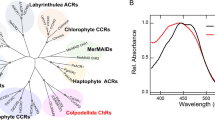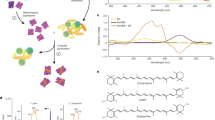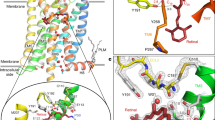Abstract
THE chemistry of photo-reception remains obscure in spite of a vast literature, particularly rich in biophysical data; indeed it is doubtful whether on the chemical side present theories are more than the merest scaffolding. Recent statements by well-known workers display a confidence about the nature of visual purple (rhodopsin) which it is not easy to share. It is said to be "safe to assume that visual purple is a conjugated carotenoid-protein" (Hecht1); rhodopsin "is a conjugated protein with a carotenoid prosthetic group called retinene; it is estimated that one molecule contains 10 prosthetic groups and that each such group contains one molecule of vitamin A" (Mitchell2). "Rhodopsin is a rose-coloured carotenoid-protein, in aqueous solution its absorption spectrum consists of a single broad band maximal at 500 mµ. In light it bleaches in a succession of photochemical and thermal reactions to orange and yellow products, liberating in the process the carotenoid retinene" (Wald3). "No doubt, therefore, the A vitamins are of importance for the formation of the ehromophoric group of the visual purple molecule, even though it may not be possible at present to describe the nature of this relationship" (Granit4).
This is a preview of subscription content, access via your institution
Access options
Subscribe to this journal
Receive 51 print issues and online access
$199.00 per year
only $3.90 per issue
Buy this article
- Purchase on SpringerLink
- Instant access to full article PDF
Prices may be subject to local taxes which are calculated during checkout
Similar content being viewed by others
References
Hecht, Ann. Rev. Biochem., 11, 476 (1942).
Mitchell, "Vitamins and Hormones", 1, 167 (1943).
Wald, "Vitamins and Hormones", 1, 215 (1943).
Granit, NATURE, 151, 631 (1943).
Krause and Sidwell, Amer. J. Physiol., 121, 215 (1938).
Wald, J. Gen. Physiol., 21, 810 (1938).
Lythgoe and Quilliam, J. Physiol., 94, 399 (1938).
Dartnell, Goodeve and Lythgoe, Proc. Roy. Soc., A, 156, 158 (1936); A, 164, 216 (1938).
Adler and v. Euler, NATURE, 141, 790 (1938).
Theorell, Biochem. Z., 279, 186 (1935).
Heilbron et al., J. Chem. Soc., 175 (1938); 128 (1939).
Duke-Elder, "Text Book of Ophthalmology", 1, 830.
Olmsted, Ann. Rev. Physiology, 1, 453 (1939).
Haas, Horecker and Hogness, J. Biol. Chem., 136, 747 (1940).
Theorell and Haas, Biochem. Z., 298, 378 (1937).
Kuhn and Wagner-Jauregg, Ber., 67, 361 (1934).
Stern and Holiday, Ber., 67, 1352 (1934).
Haas, Biochem. Z., 290, 291 (1937).
Kuhn and Ströbele, Ber., 70, 753 (1937).
Duke-Elder, "Text Book of Ophthalmology", 1, 820.
Author information
Authors and Affiliations
Rights and permissions
About this article
Cite this article
MORTON, R. Chemical Aspects of the Visual Process. Nature 153, 69–71 (1944). https://doi.org/10.1038/153069a0
Issue date:
DOI: https://doi.org/10.1038/153069a0
This article is cited by
-
Der Einflu� von Lactoflavin auf den Verlauf der elektroretinographischen Dunkeladaptation und der spektralen Empfindlichkeit des Froschauges
Pfl�gers Archiv f�r die Gesamte Physiologie des Menschen und der Tiere (1962)



